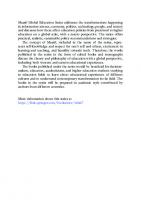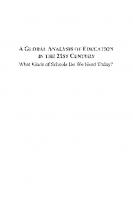A Global Analysis of Education in the 21st Century: What Kinds of Schools Do We Need Today? 9781495503573, 1495503577
This book analyzes the quality, challenges and prospects of 21st century education worldwide.
112 28 56MB
English Pages 368 [397] Year 2015
A GLOBAL ANALYSIS OF EDUCATION IN THE 21ST CENTURY
TABLE OF CONTENTS
ABSTRACT
FORWORD
ACKNOWLEDGEMENT
PART ONE
CHAPTER 1
CHAPTER 2
CHAPTER 3
PART TWO
CHAPTER 4
CHAPTER 5
CHAPTER 6
CHAPTER 7
PART THREE
CHAPTER 8
CHAPTER 9
CHAPTER 10
REFERENCES
Index
Recommend Papers
File loading please wait...
Citation preview
GLOBAL ANALYSIS OF EOUCATION IN THE 21sT CENTURY SELINA LESIAKJ PROSPER MUSH!
A GLOBAL AN~4.LYSIS IN THE 1 CENTURY What Kinds of Schools Do We Need Today?
A GLOBAL ANALYSIS IN THE 21sT CENTURY
What Kinds
Schools Do We Need Today?
Selina Lesiaki Prosper Mushi
With a Foreword by
Barry van Driel
Edwin Mellen Press Lewiston ~ Lampeter
Library of Congress Cataloging-in-PubUcation Data
Mushi, Selina Lesiaki Prosper. A global analysis of education in the 21 st century: what kinds of schools do we need today? / Selina Lesiaki Prosper Mushi ; edited and with a foreword by Barry van Driel. p. cm. Includes bibliographical references and index. ISBN-13: 978-1-4955-0357-3 (hardcover) ISBN-I0: 1-4955-0357-7 (hardcover) I. Education--Aims and objectives--Cross-cultural studies. 2. Education and state--Cross-cultural studies I. Title. II. Title: A global analysis of education in the twenty-first century. LB41.M978 2015 370.1--dc23 2015019315
hors serie. A CIP catalog record for this book is available from the British Library.
Copyright
© 2015
Selina Lesiaki Prosper Mushi
All rights reserved. For information contact The Edwin Mellen Press Box 450 Lewiston, New York USA 14092-0450
The Edwin Mellen Press, Ltd. Lampeter Ceredigion, Wales UNITED KINGDOM. SA48 8LT
Printed in the United States of America
DEDICATION
To my beloved father, Lesiaki Prosper Matzinde Mushi, and my beloved mother Mkakyipati Oliva Ndepfiangao Maswai, whose genetic material I carry in my body and brain; and To my beloved sons and daughter, Andrew, Frederick and Regina, as always.
TABLE OF CONTENTS Page Abstract
i
Foreword by Barry van Driel
iii
Acknowledgement
vii
PART ONE: STOP AND THINK GLOBALLY: WHERE IS EDUCATION HEADED?
1
Chapter 1: Education for What?
3
Introduction
3
Education From Childhood to Old Age
5
Struggles for High Quality Education
8
What is "High Quality Education"?
9
The Formal Education Systems of the 20th Century
14
Evplution of Formal Education
16
The Need for Catalyst Education
19
Methodology
21
Chapter 2: An Overview of Educ.ation in Industrialized Societies 23 Introduction
23
Access to Formal Education in the Highly Industrialized 24 Countries What Does "Access to Education" Mean?
29
Technological Advancements and Formal Education in Industrialized Countries
32
Efforts to Understand the Impact of Technology-Enhanced Learning in the United Kingdom 37 Integration of Technology in Education in East Asia
41
Integration of Technology in Education in South East Asia
45
Technology Integration in Formal Education in Canada
47
Technology Integration Trends in Formal Education in the United States
50
Overall Trends of Technology Integration inFormal Education in Industrialized Countries
52
Chapter 3: An Overview of Education in Less Industrialized Societies
55
Introduction
55
Traditional Education Systems
57
The Kilimanjaro Traditional Education System
59
Traditional Education Teaching Methods
71
Key Players in Traditional Education
76
Achievements of Traditional Education
76
Lessons From the Kilimanjaro Traditional Education System
81
Formal Education in the Less Industrialized Societies
85
Formal Education in Botswana
89
Formal Education in Ghana
93
Formal Education in Brazil
97
Formal Education in Argentina
103
Formal Education in India
107
Formal Education in Mongolia
110
Formal Education in Romania
113
Overall Trends of Formal Countries
in Developing 118
Conclusion
121
PART TWO: GLOBAL EDUCATION
IN
Chapter 4: Quality and Profit in
Education
Industry
127
Introduction
127
The Business of Education
132
False Con-elations
137
Total Revenues Minus Expenses in Formal Education
141
Nationally Funded Formal Education
143
Privately Funded Fonnal Education
145
Nationally Led But Privately Funded Fonnal Education
146
Conclusion
147
5:
Digital Race and Education
Quality
149
Introduction
149
Evolution of Leaming Technologies
151
Paradoxes Facing Learning in the Digital Age
155
Technology Use in Ea~ly Childhood Development and Technology Use and Quality
159
Primary Education
161
Technology Use and Quality in Secondary Education
165
Technology Use and Quality in Tertiary Education
167
Online Teaching
169
Technology Use in Catalyst Education
171
Conclusion
171
Chapte:r 6: "Use My Brain Not Yours" A Few Thinkers to Run the World
] 75
Introduction
175
The Technological Evolvement Pipeline
179
The 20th Century Thinkers
183
The Busy Skill Seekers
185
Dreamers and Innovators
187
Twenty-First Century Riders of Fast Technology
189
Perception of Complexities of the World as "Given"
191
Leaving the Thinking to Machines
192
Dangerous Ease of Manipulation
195
Conclusion
196
Chapte:r 7: Acquired Dependency Synd:romes Ac:ross And within Countries
197
Introduction
197
Developing Countries' Dependence on Industrialized Nations for Educational Technology
199
Conditional Dependency
200
Industrialized Countries" Dependence on 201
Developing Nations Interdependence Between Developing Countries
203
Within-Country Dependency
203
School Funding Practices
Industrialized
Countries
204
Status Dependency in Industrialized Nations
208
School Funding Practices in Developing Countries
209
Status Dependency in Developing Countries
211
Dependency on Flawed Assessment
215
Brain Drain
220
. Global Imbalance
2·22
Conclusion
223
PART THREE: PROSPECTS OF EDUCATION
225
AS A GLOBAL SYSTEM
8:
Industry is a
System
227
Introduction
227
Absorption
Education into Modem Technology
229
Absorption of Modem Technology into Education
231
Interdependency of Global Curriculum
233
Managing the Direction of Education Globally
239
Forces Underlying Education Worldwide
241
Technology Hurdles in Global Formal Education
247
Conclusion
248
Chapter 9: True Investment in Formal Education
251
Introduction
251
Investment in Lea.'11er Attitudes
255
Triggers of Needs Assessment
256
Investment in Learning Facilities
259
Investment in Teaching Personnel
261
Investment in Curriculum Planning and Implementation
265
Investment in Materials Selection and Development
270
Investment in Equipment
271
How are Students Faring in Higher Education Costs?
272
Investment in Learning Outcomes Assessment
277
Investment in Administrative Staff
280
The Role of Community-Owned Databases
281
Using Global Databases to Inform Investment Decisions
281
Conclusion
283
Chapter 10: Community-Owned, Globally Transparent Schools
285
Introduction
285
Students Need More Than Cocooned Education
289
Ignorance of Ignorance
295
Higher Education Transparency
296
Case
Community-Owned, Globally
Transparent Formal Education
297
The Catalyst School
299
COlTh."11unity
The Role of Catalyst Education in Society
301
Global Catalyst Education
303
Recruiting Committed Teachers
305
Early Introduction to Possible Careers
309
Challenges
3 12
Conclusion
315
References
317
Index
357
ABSTRACT This book analyzes the quality, challenges and prospects of 21 st Century education worldwide. Part One of the book raises key questions about the role and direction of education in industrialized as \-veU as developing countries. Part Two of the book addresses key challenges facing formal education. The challenges identified are quality versus profit-making in the education industry, interaction of quality and the digital race, learners' abilities to think critically, and dependencies. Part Three of the book highlights global prospects for 21 st Century education. I make a strong case for catalyst education, with locally owned, globally transparent schools.
As I start to vvrite fore\vord to this very interesting book I am sitting on the train I take to Amsterdam several times a week to work at the Anne Frank House. I cannot help but notice that where in the past people would be newspapers or chatting softly about the day's events, there is now total silence, disrupted by occasional 'ping'. The large majority of travelers are glued to their devices, ever looking up to see what is happening the 'real virtual world seems far more interesting and more compelling. """".>1U!';
I decide to also pull out my device and how the students at the University of Amsterdam are occupymg buildings because the profit motive has come to dominate at the University. Many non-profitable programs that have been in existence for many decades are being cut, especially foreign language programs. They simply do not bring in enough money.
In his report to UNESCO at end of century, former European Commission President Jacques Delors authored the report Learning: The Treasure Within. The report conceptualized what education and learning worldwide should look like in 21 Sf century. He identified 4 major pillars of lea.'11ing: Learning to know, learning to do, learning to be and learning to live together. His vision was a broad one. He felt it was critical to focus on ranging from globalization to knowledge society, social cohesion, inclusion, exclusion, gender equality, and democratic
participation. He already identified at that time the threats to quality education associated with technological advances, such as losing one's cultural identity and uniqueness and the ability to play an active part in the life of one's nation and local community. He also points to the risk of creating a society and education system that forgets the unique character of individual human beings. His warnings have hardly been heeded. The rapidly growing Global Educational Refornl Movement (GERM) is presently having a profound impact on education and is cementing the power of industry and market mechanisms on the future of education. The overriding assumption is that market mechanisms are the best vehicles for improving the quality of education; This goes for all levels of education. It brings multinationals and their profit motive into the classroom. This is nicely illustrated by the phrase on the wall of a New York City high school portrayed in the new documentary 'Tested' by director Curtis Chin. The phrase says: 'Learning is Earning'. The documentary depicts how standardized testing and the sole focus on earning has strengthened existing inequalities and created new inequalities. Quality education has been reduced to high scores on standardized tests (in this case the SAT) I get home from my train trip and my 6-year-old daughter is learning to read using Bug Club, eyes glued to the computer screen. She gets immediate feedback and catchy tunes keep her motivated. It all seems to be innocent, though I have my issues with how 'good'; and 'bad' are iv
presented. Perhaps I should not be surprised that the producers of Bug Club are a multinational company with 40,000 employees (or so they claim). They claim that their main goal is simple: to more of lives Their site mentions great projects they
seems to be acquiring a ehal tcnges identified and discussed are complemented by as a global discussed
book.
and
Selina Mushi goes beyond rhetoric, to the criticism of
11slng looks at the
negative
Detors, Jacques et Paris: UNESCO
vUl
![Europe's Hybrid Threats : What Kinds of Power Does the EU Need in the 21st Century? [1 ed.]
9781443891844, 9781443881791](https://ebin.pub/img/200x200/europes-hybrid-threats-what-kinds-of-power-does-the-eu-need-in-the-21st-century-1nbsped-9781443891844-9781443881791.jpg)









